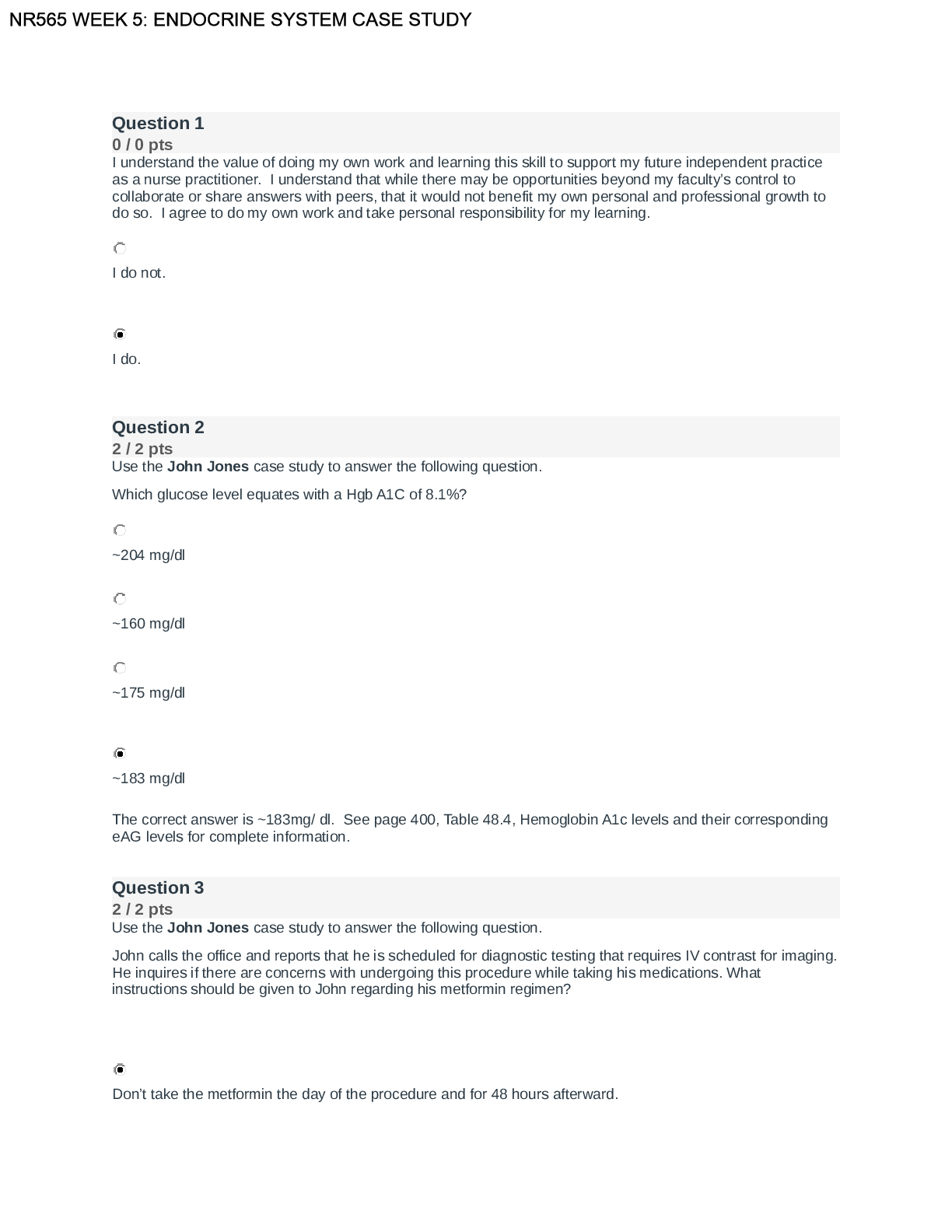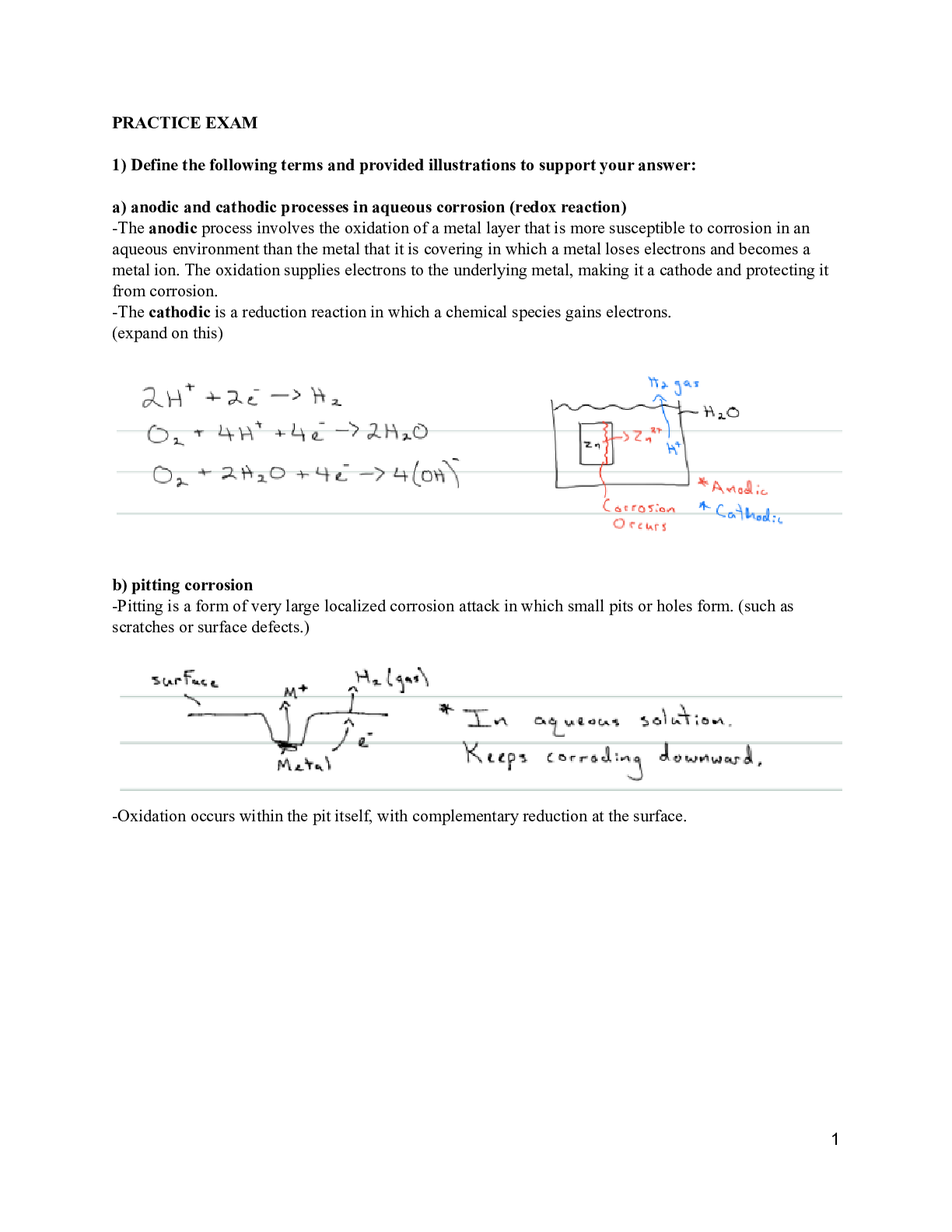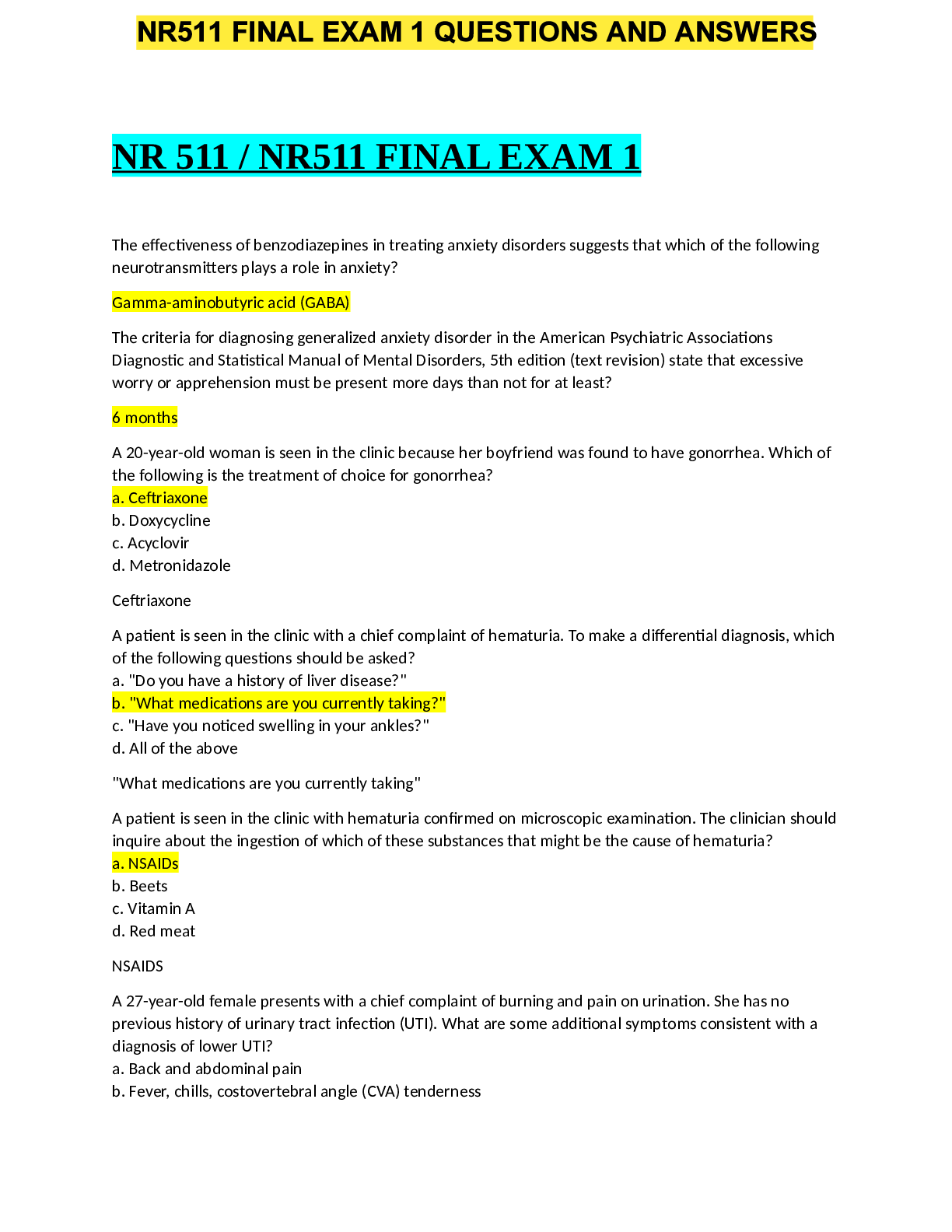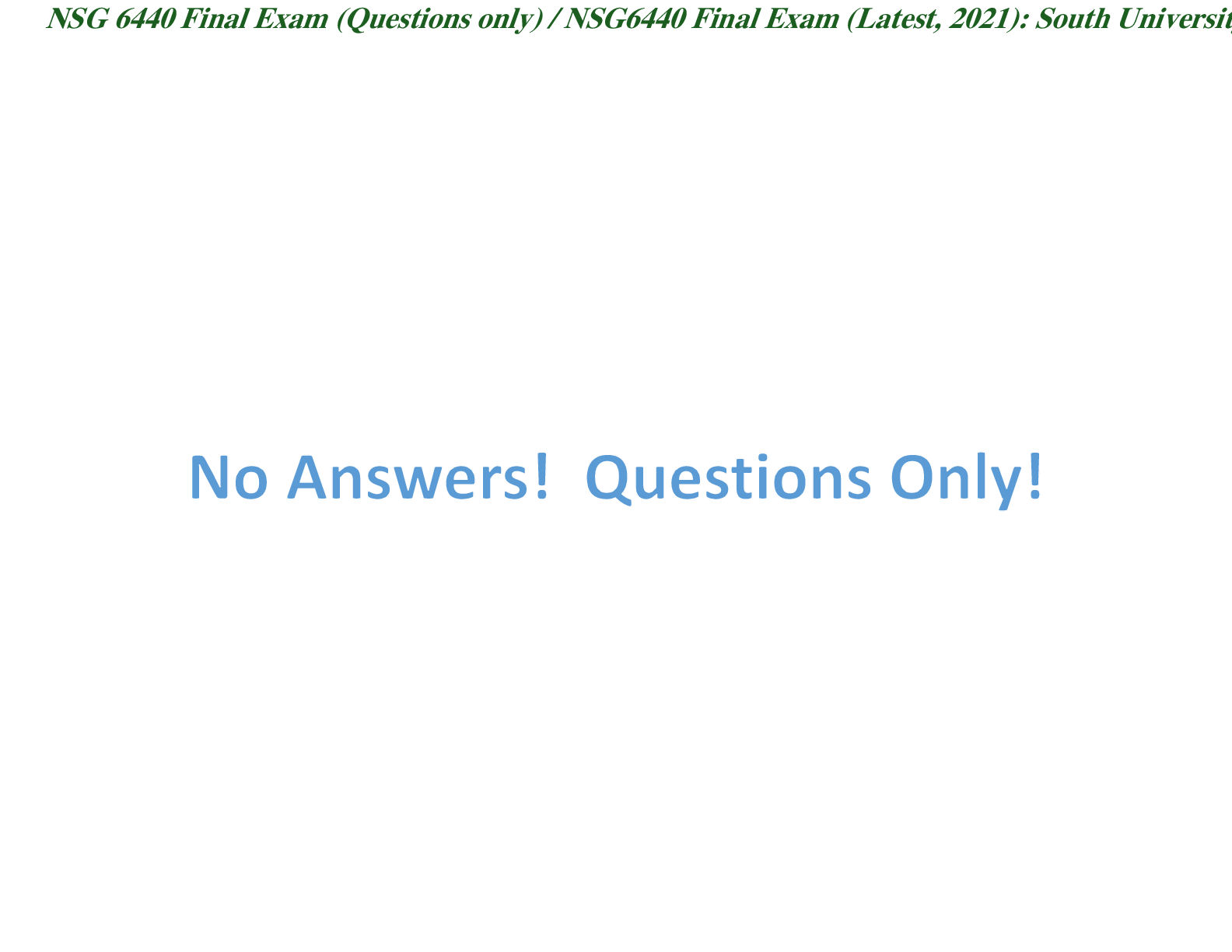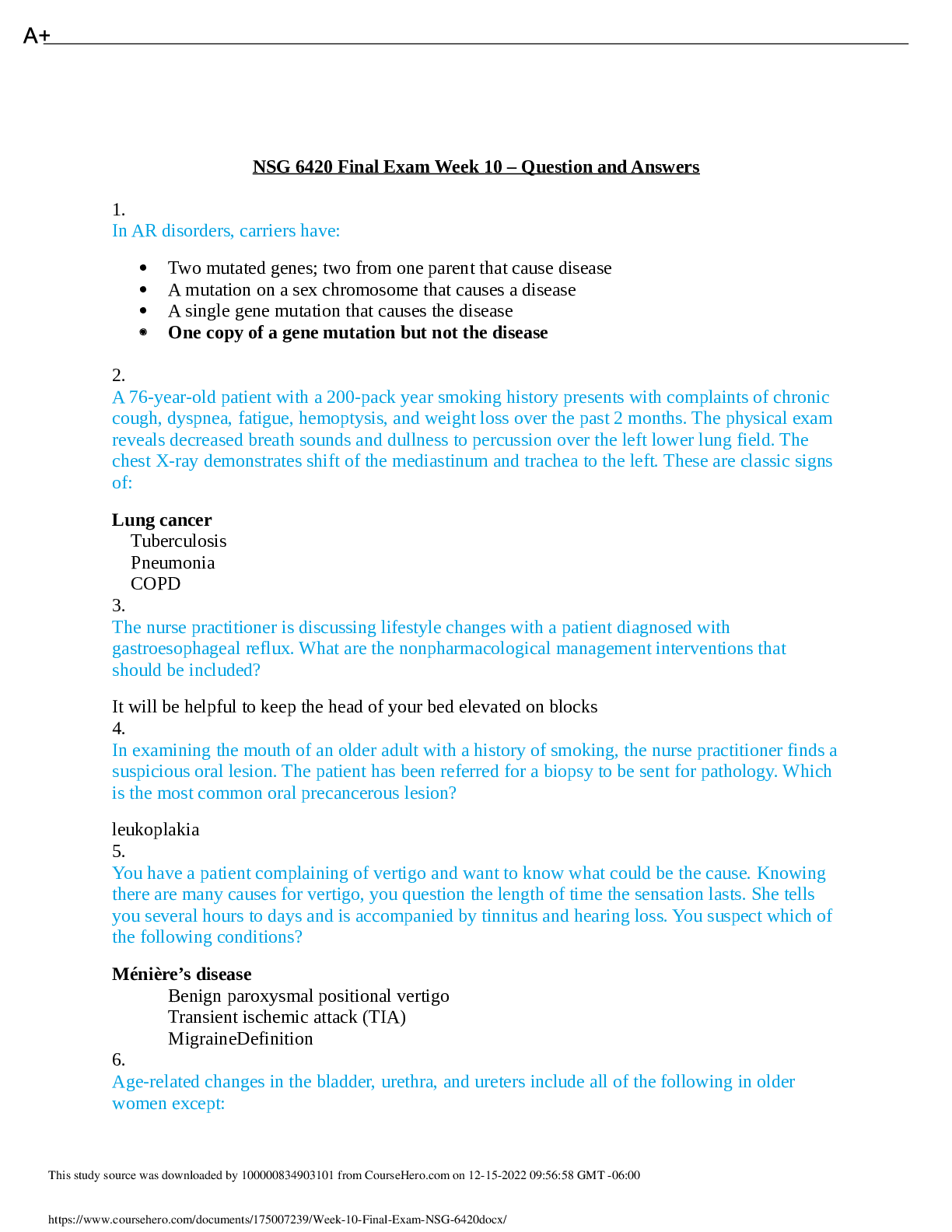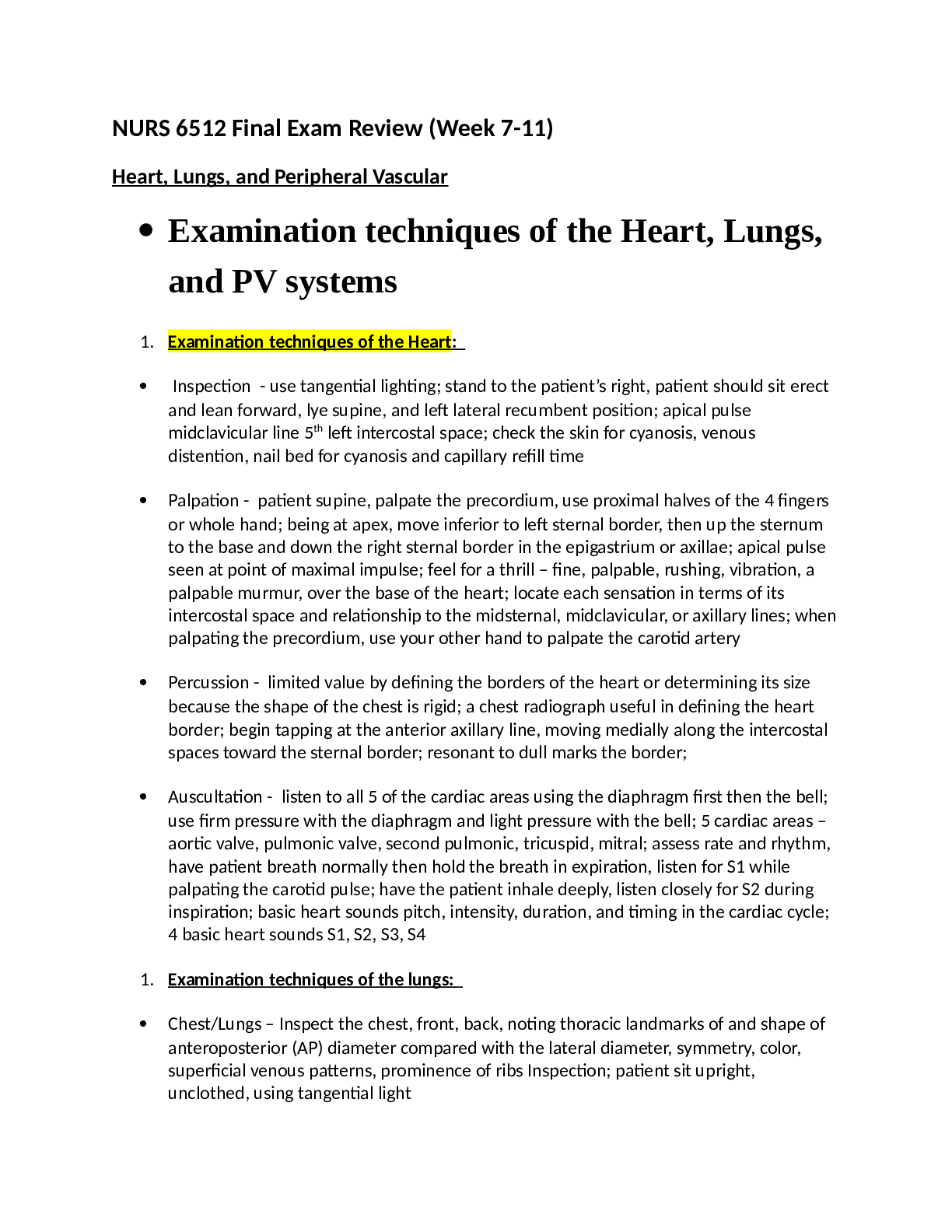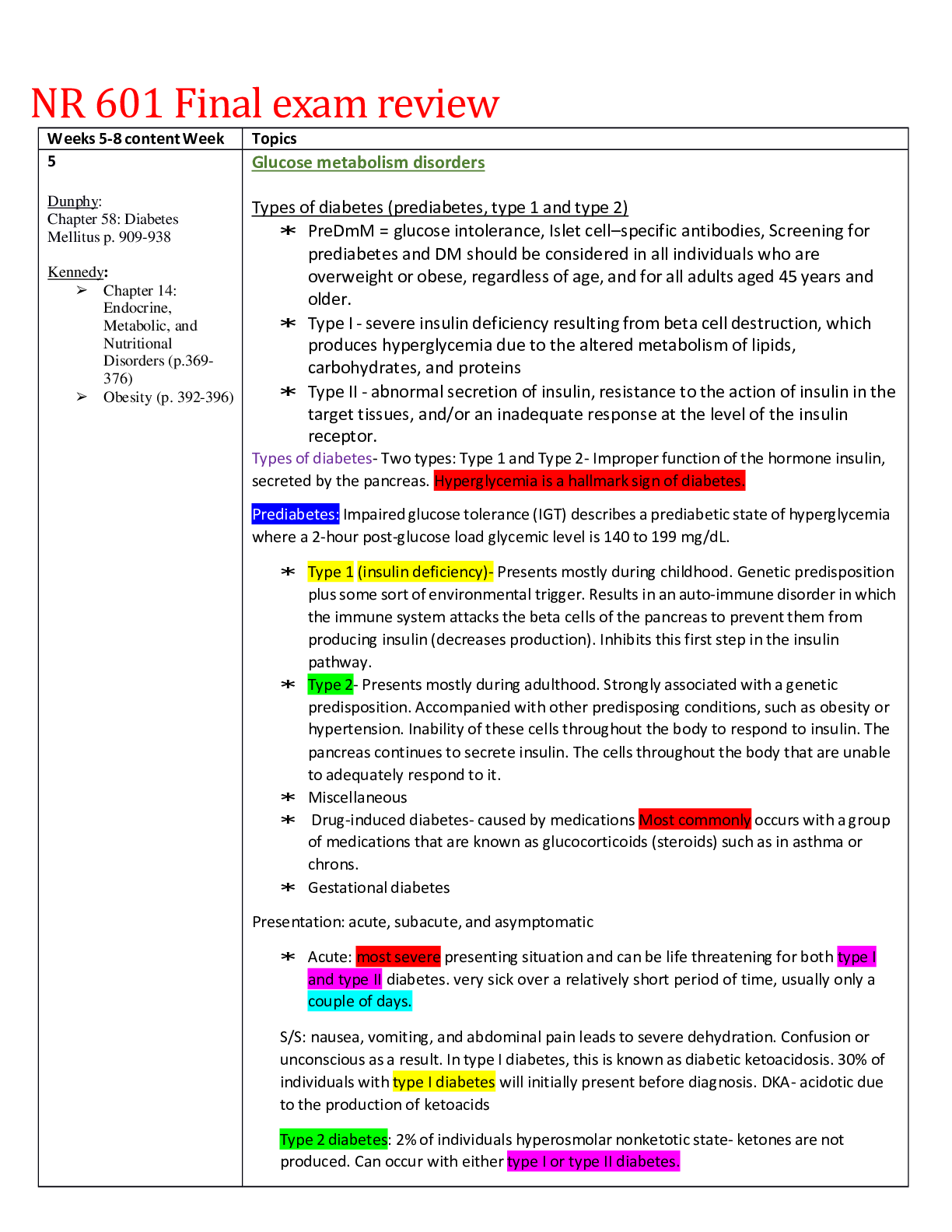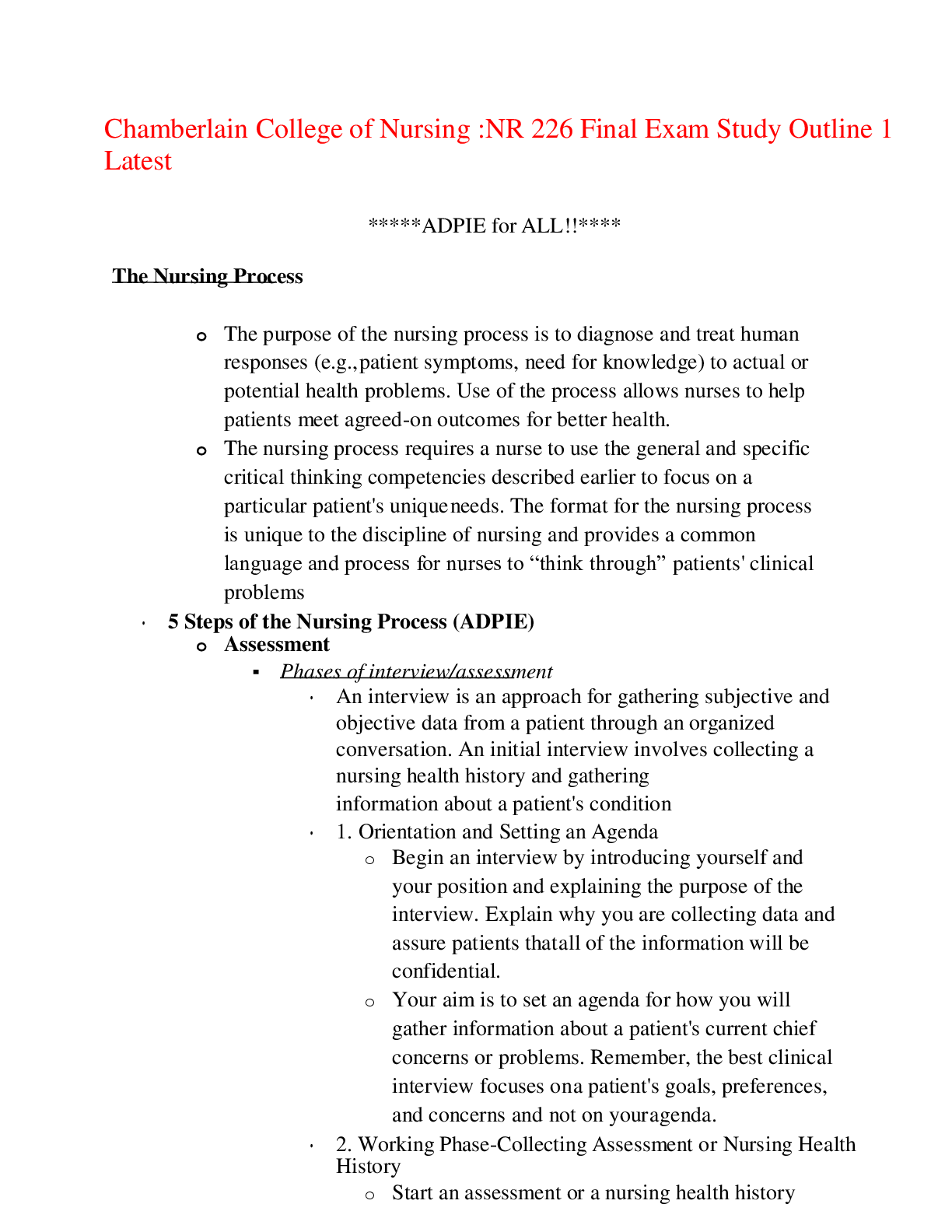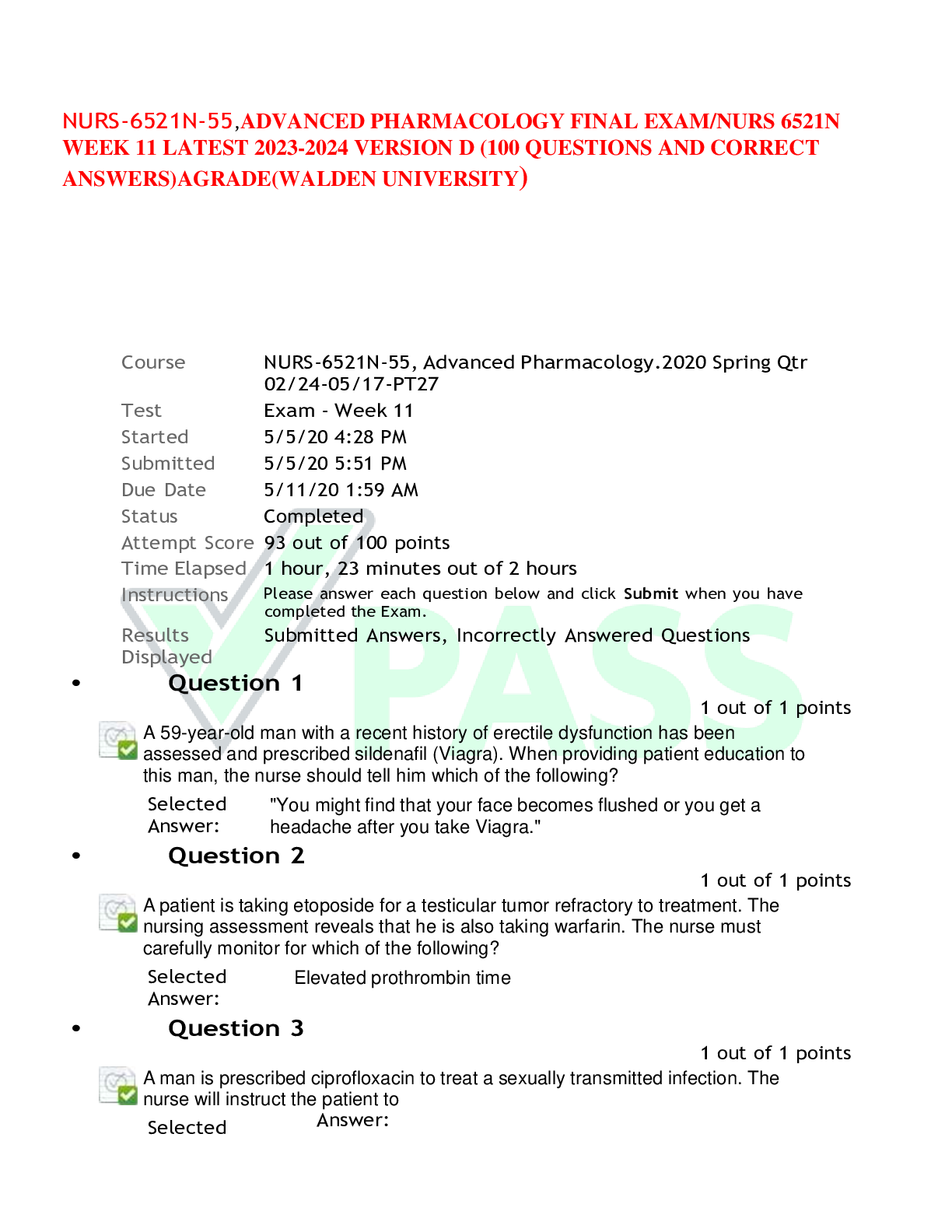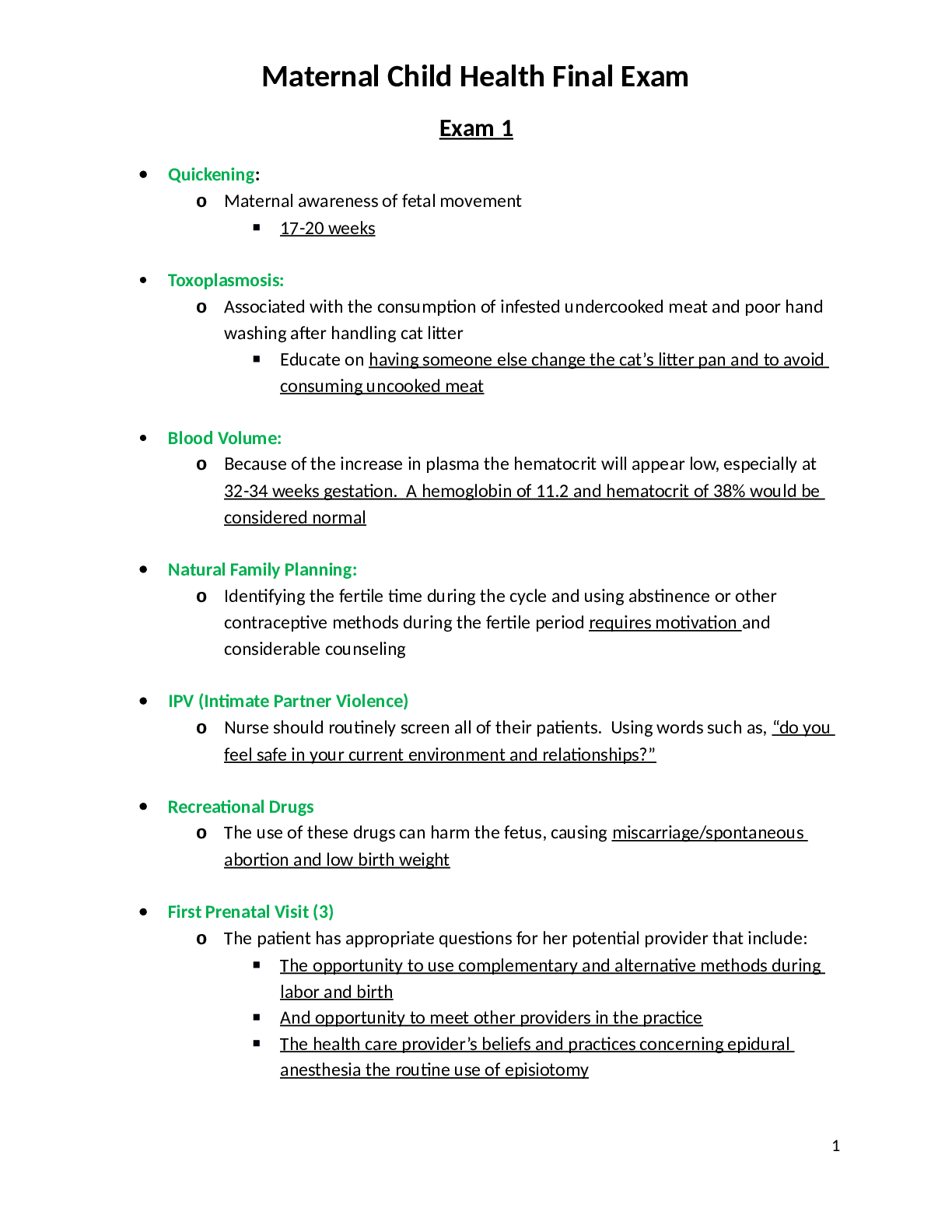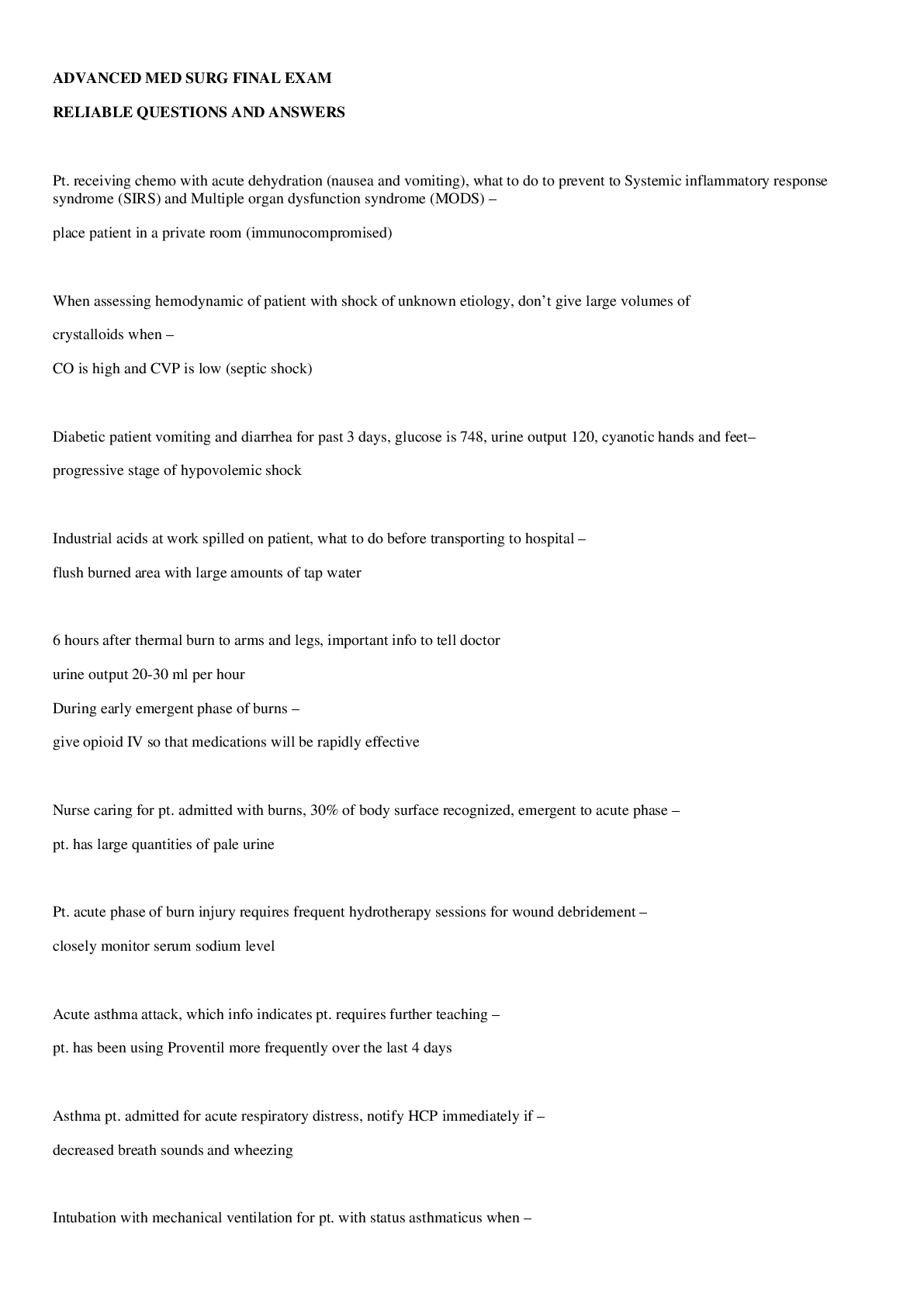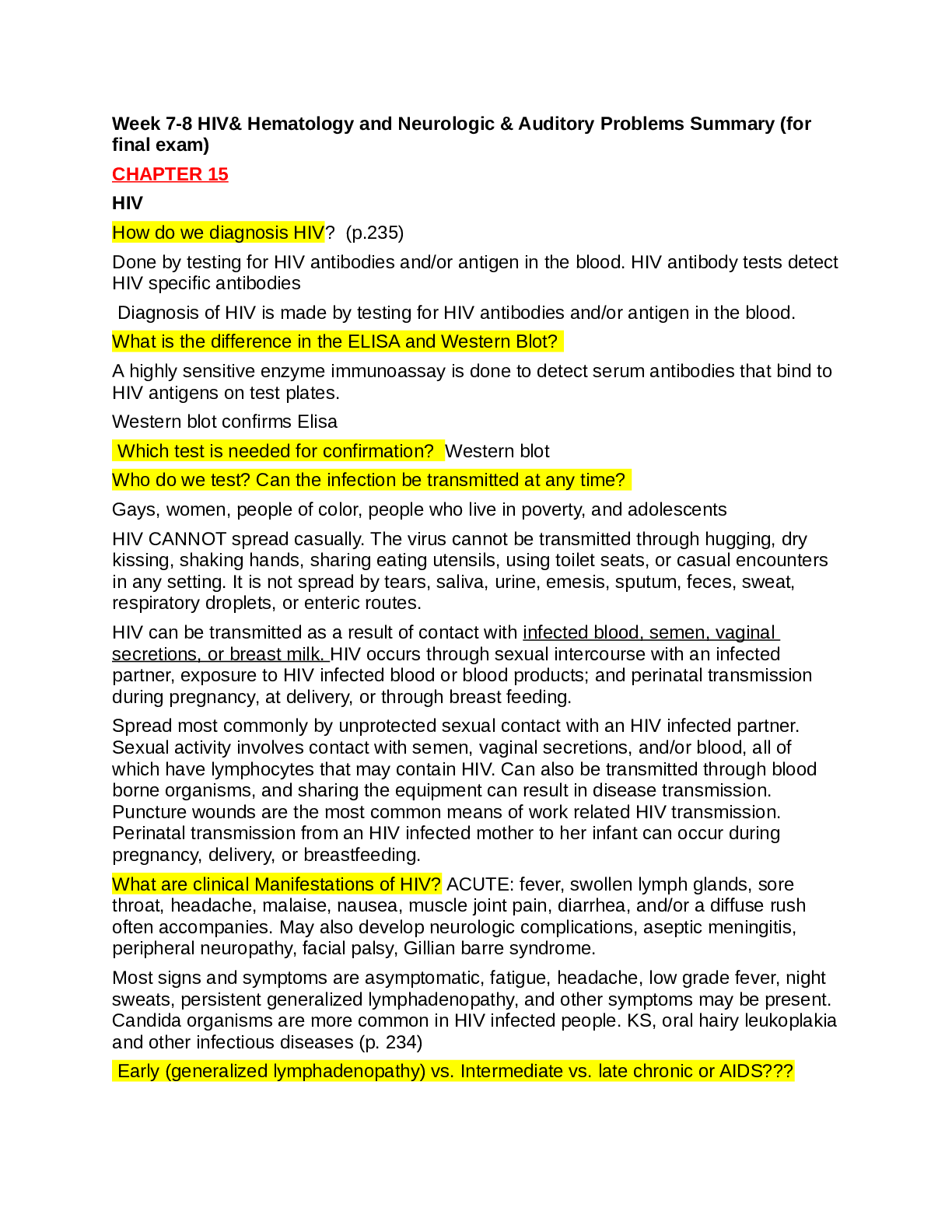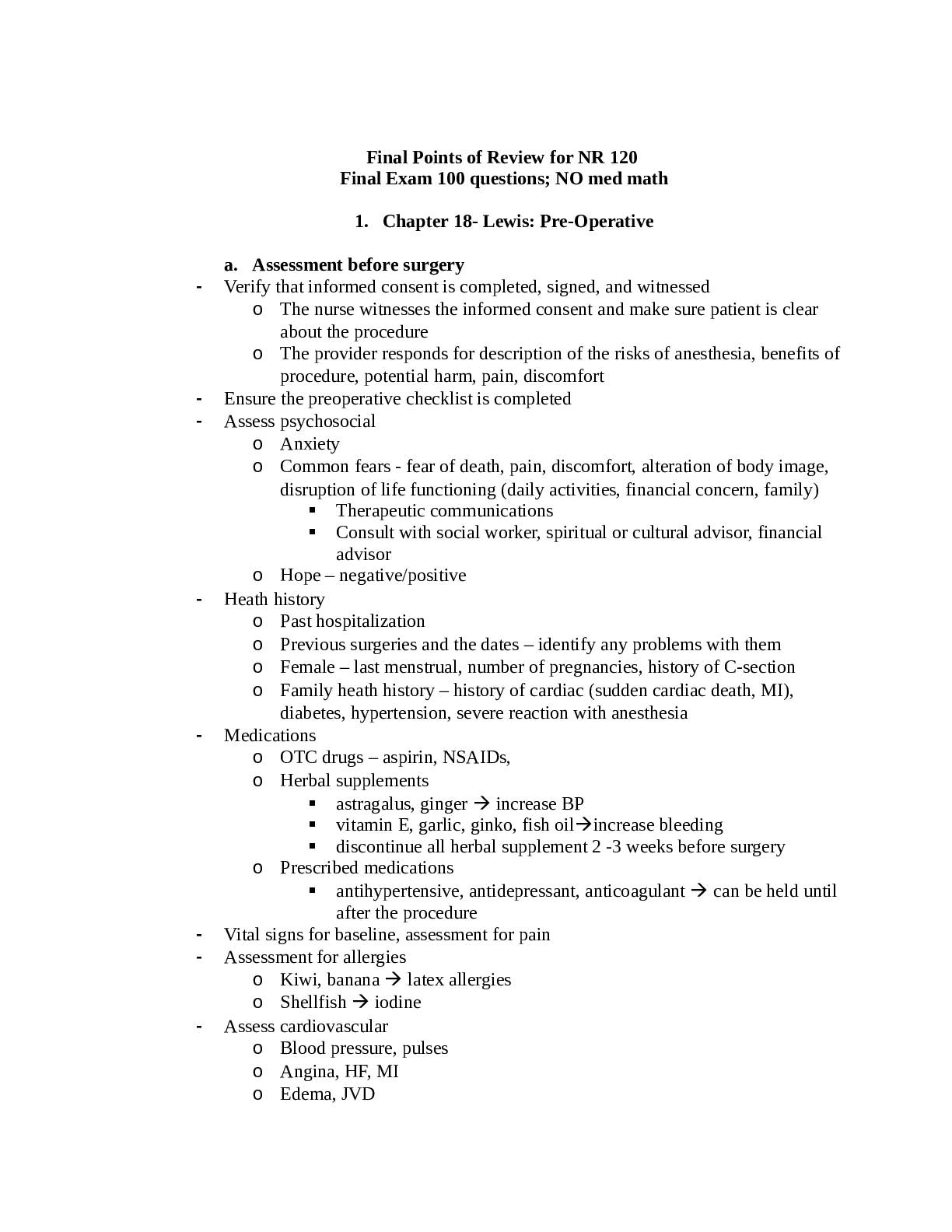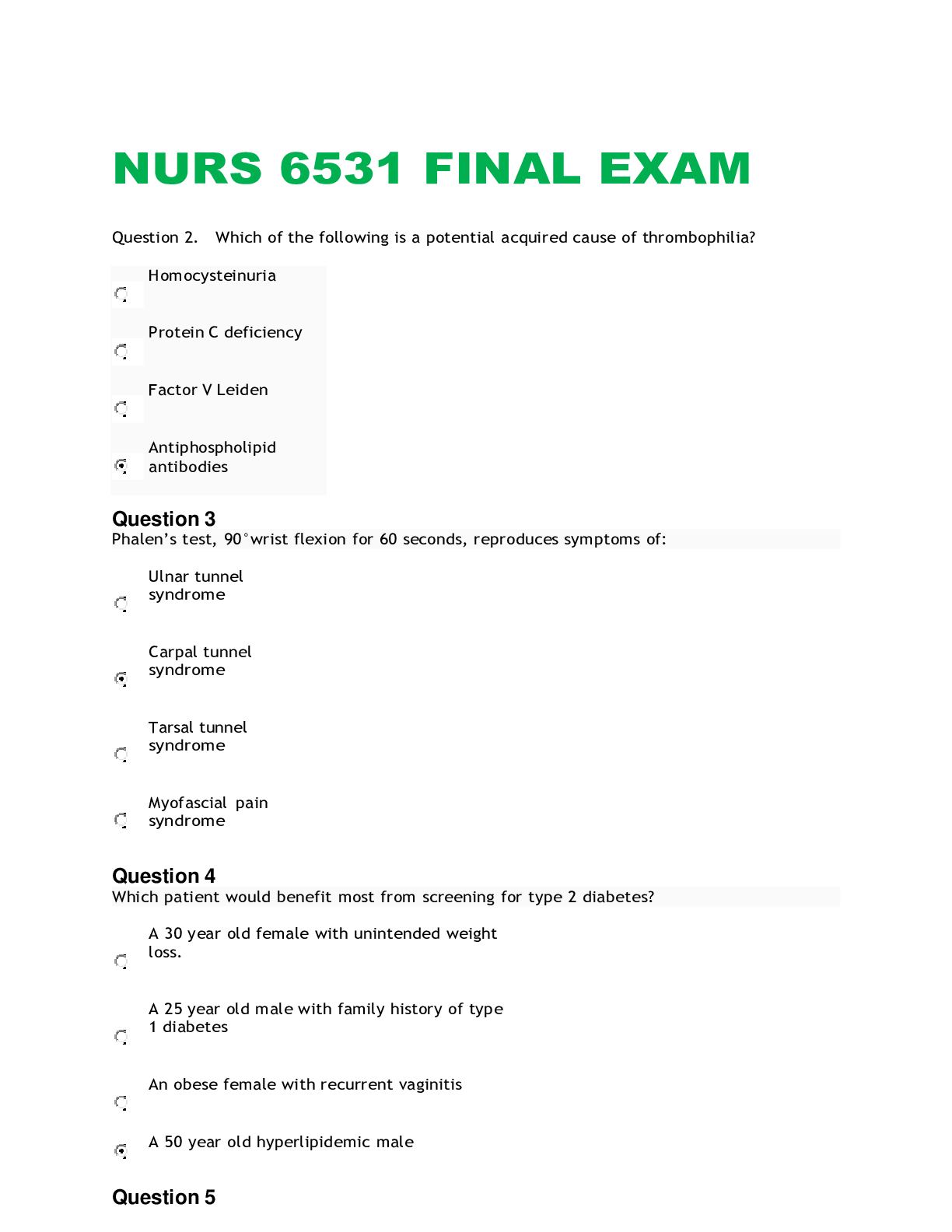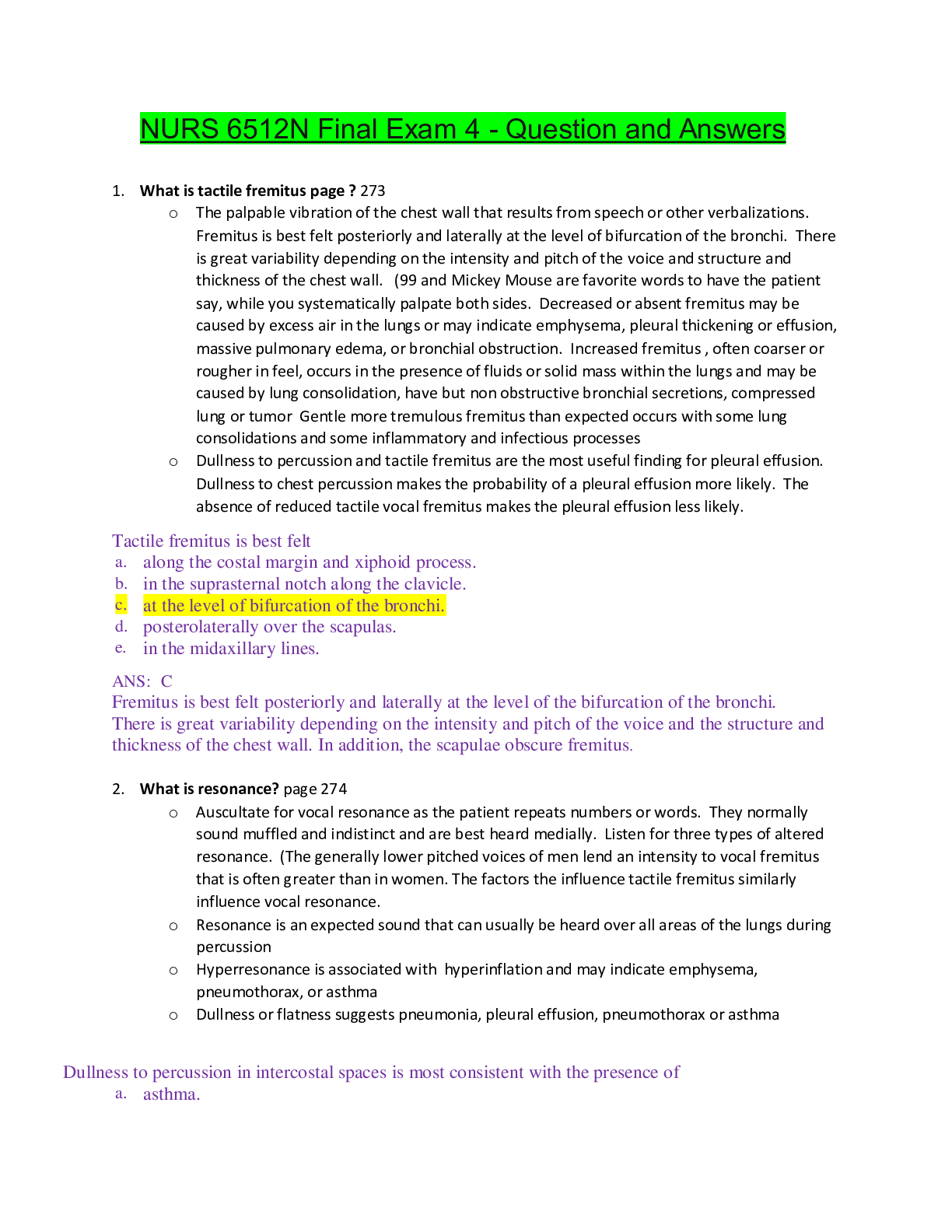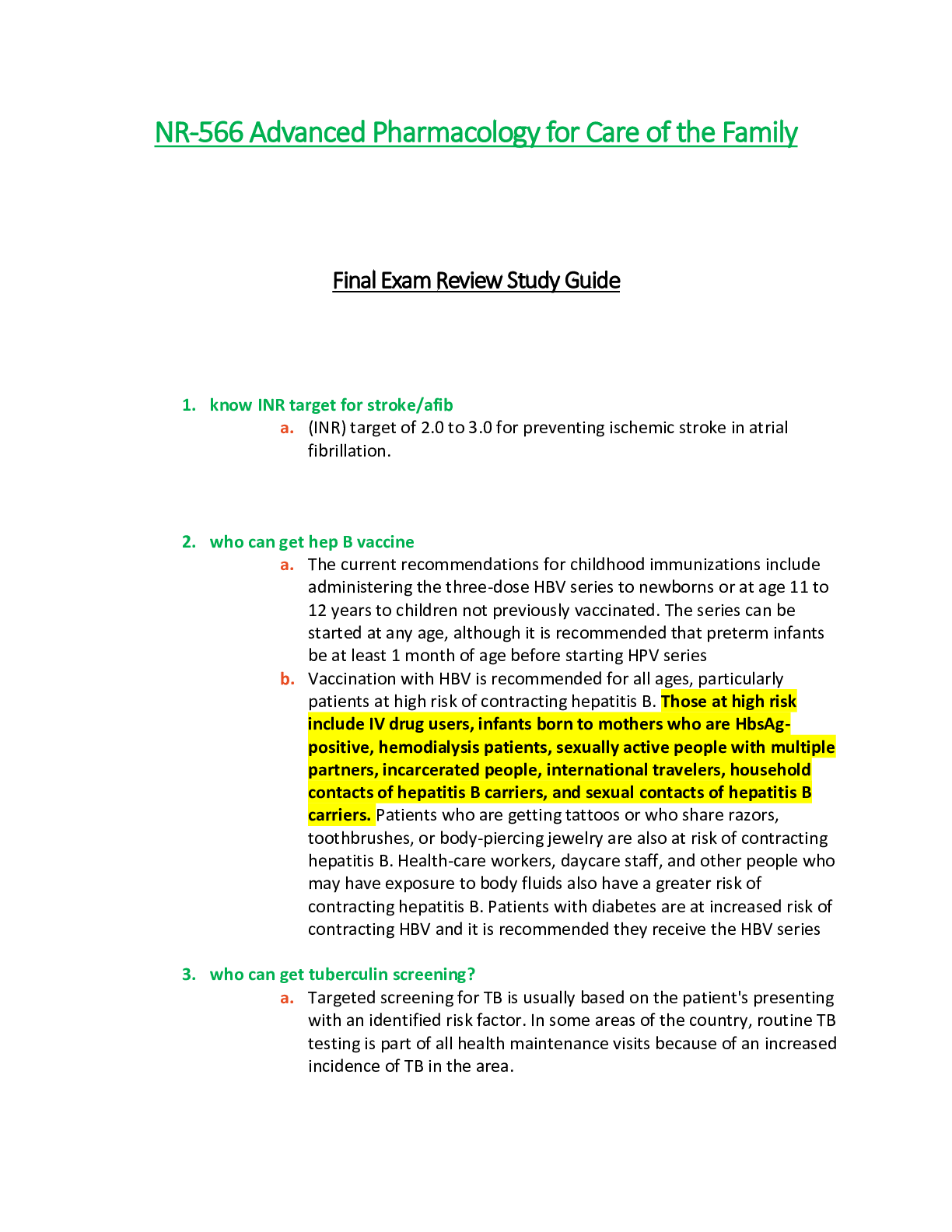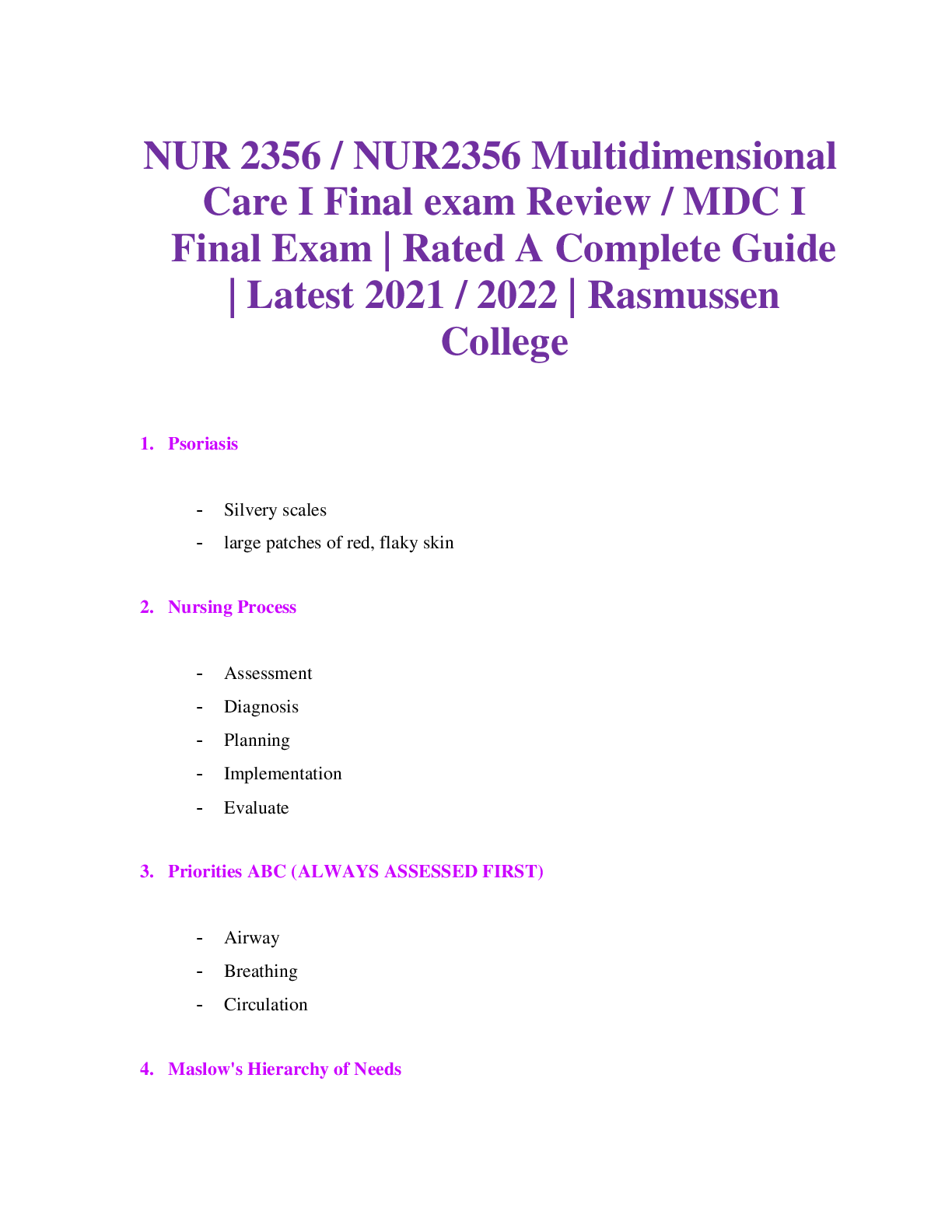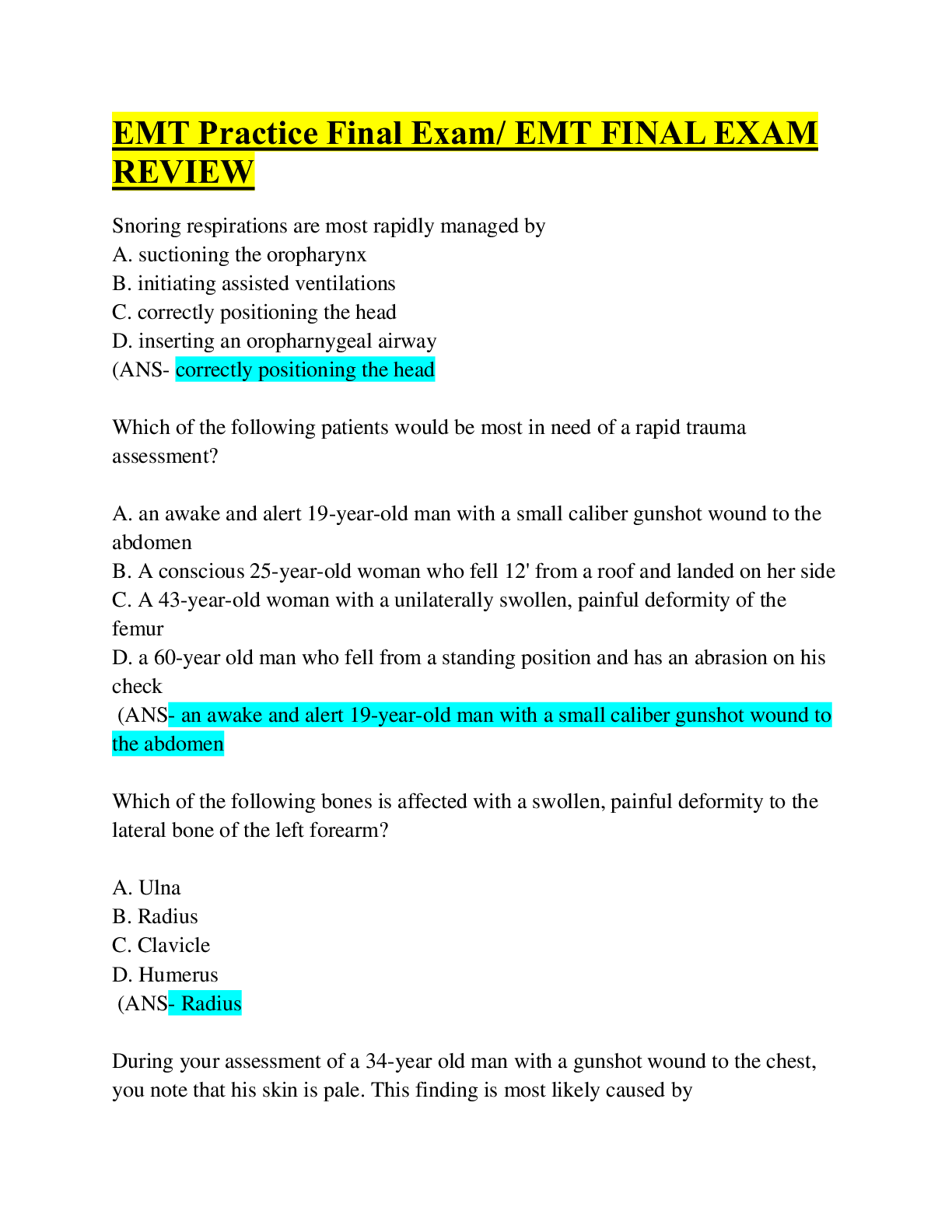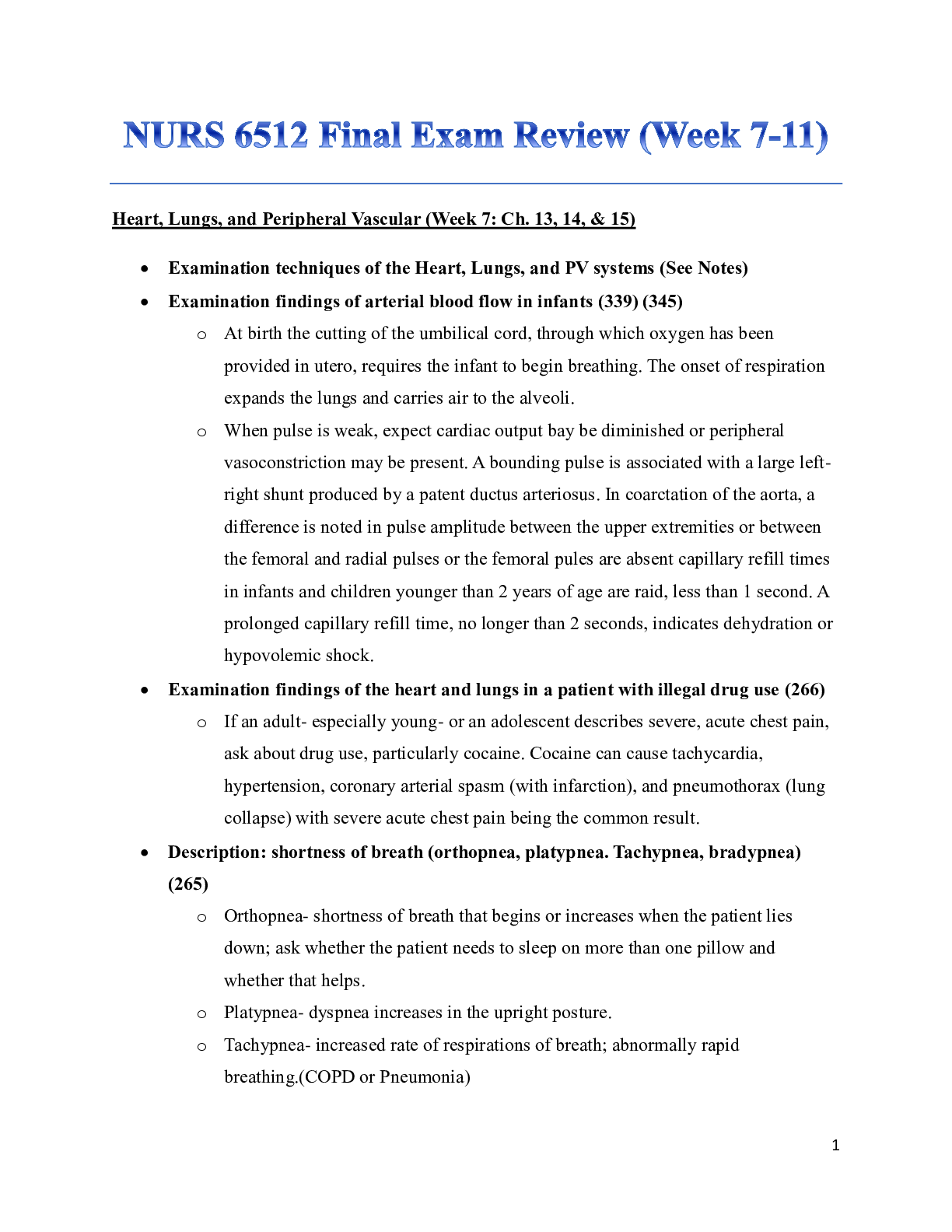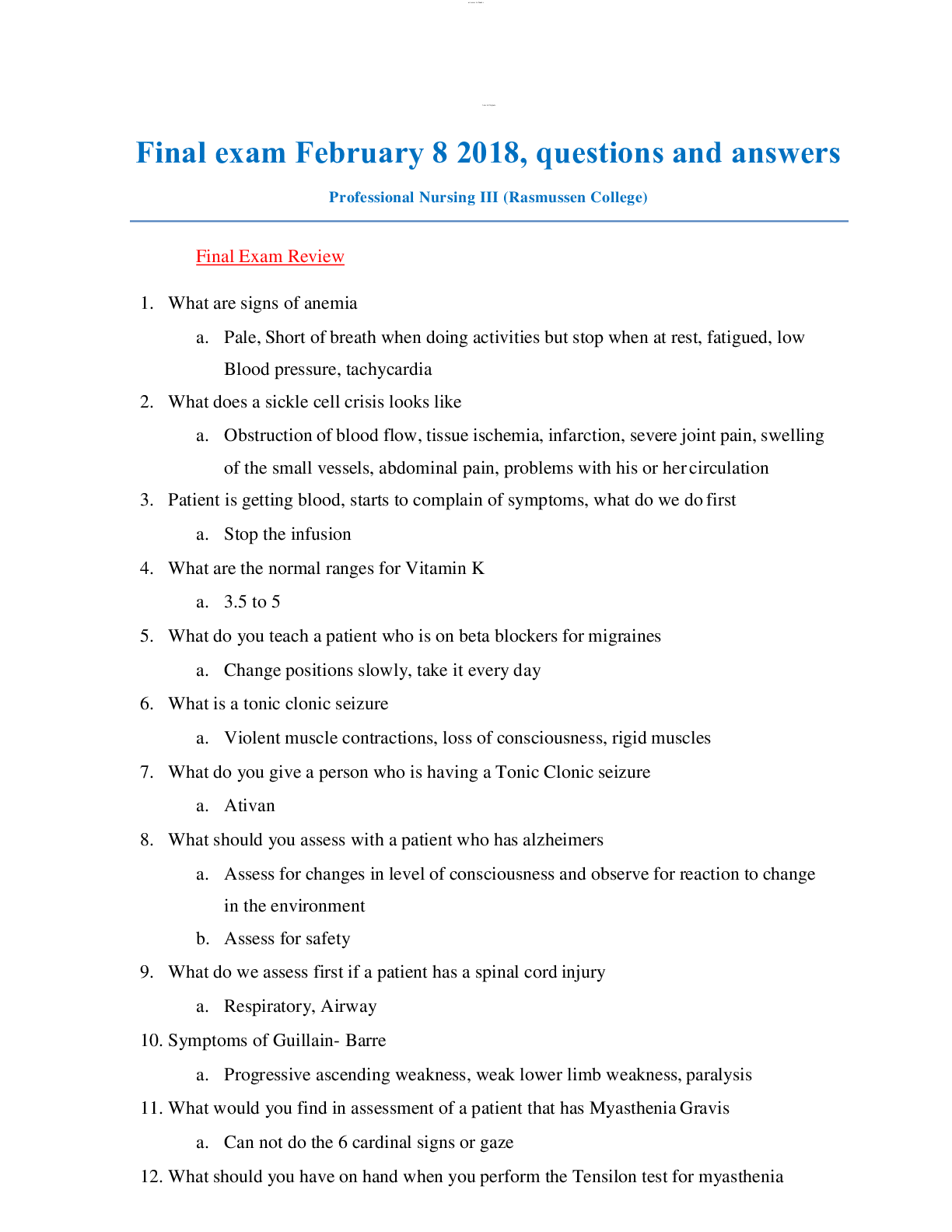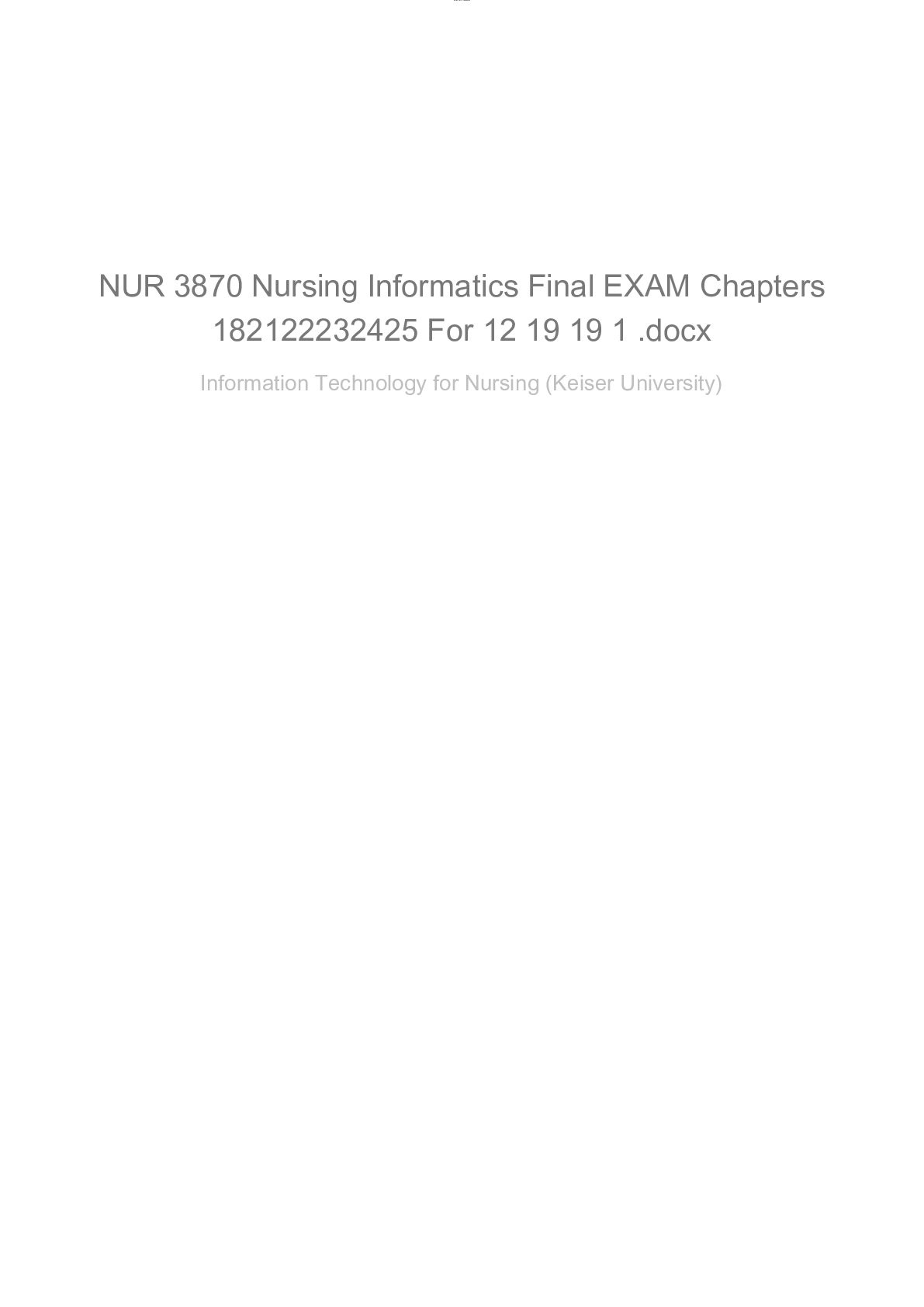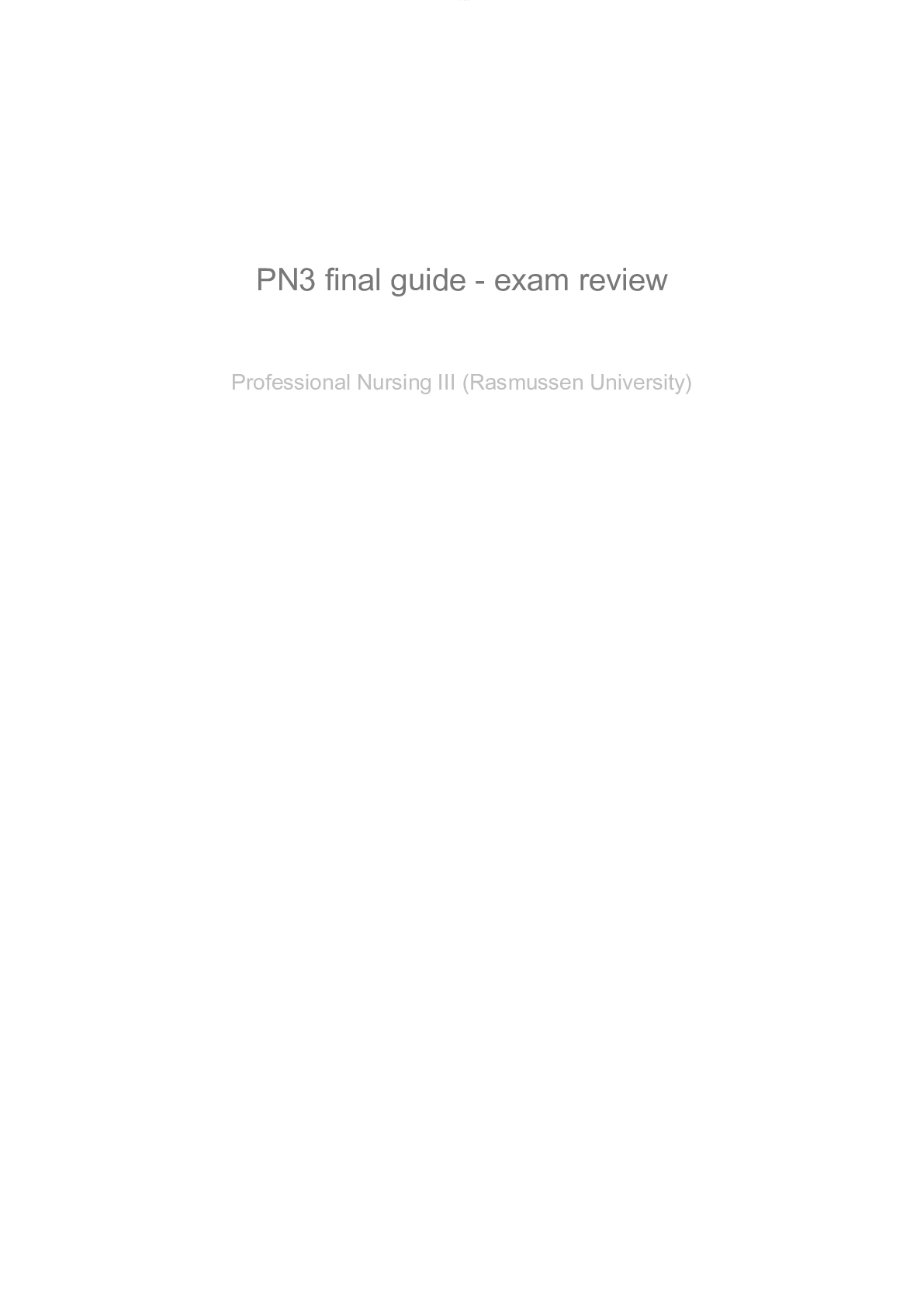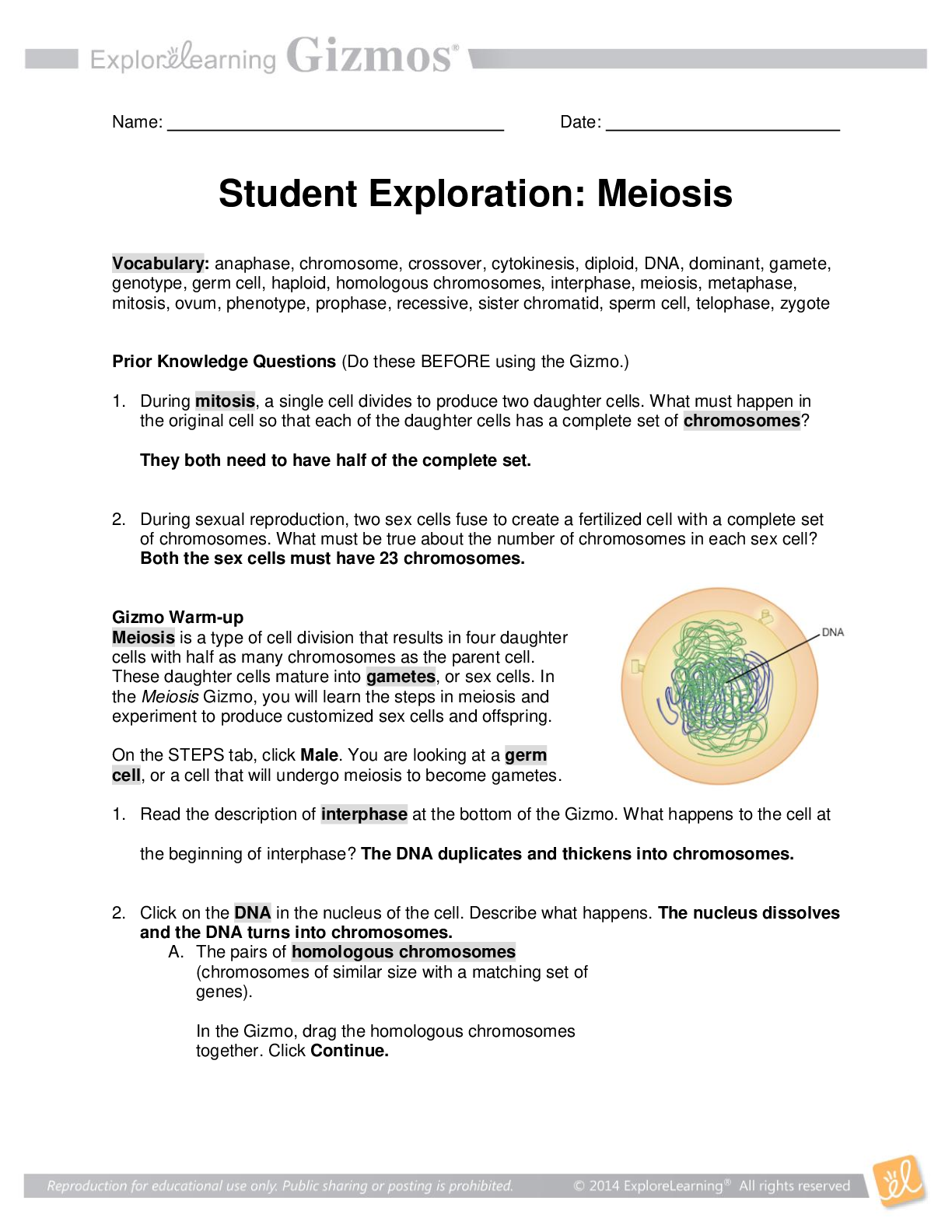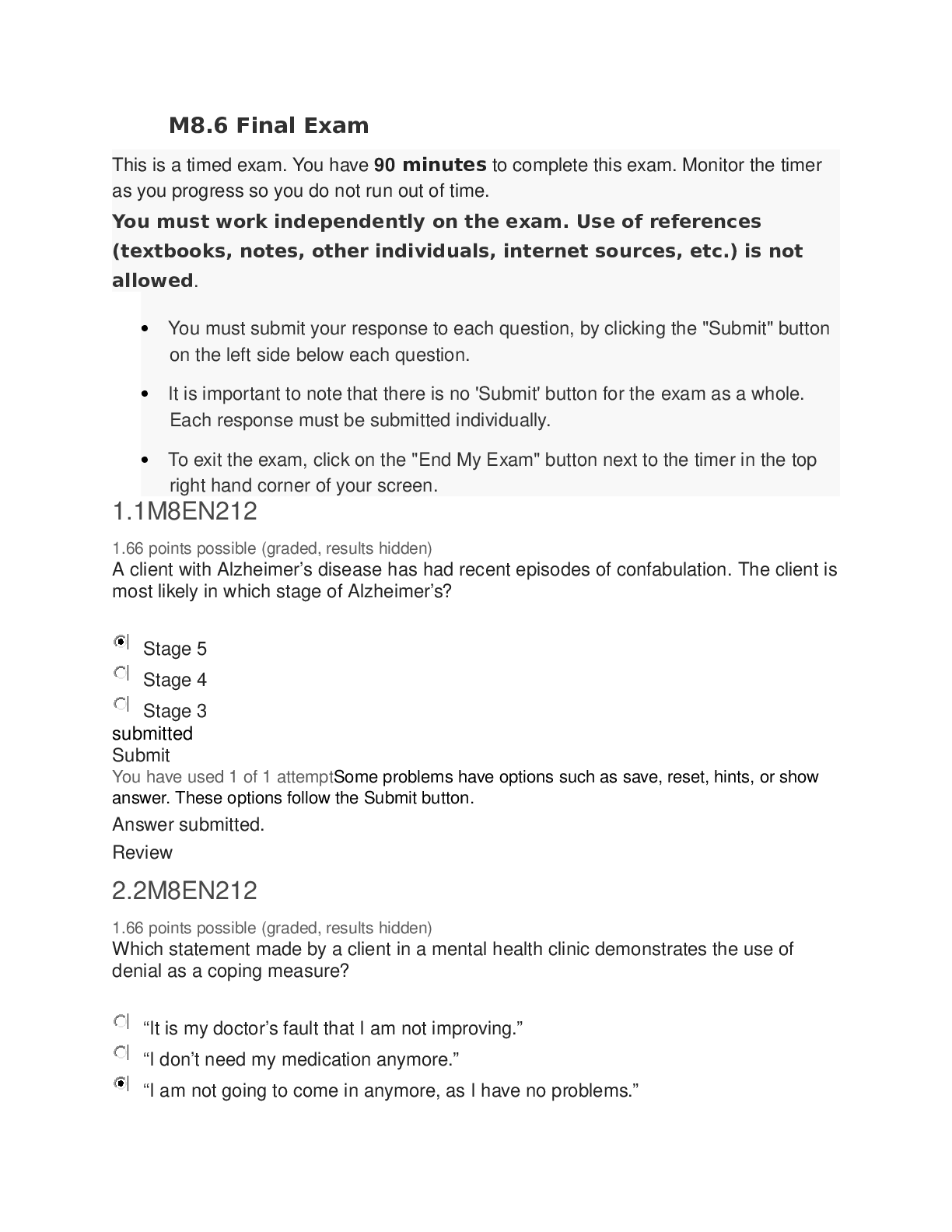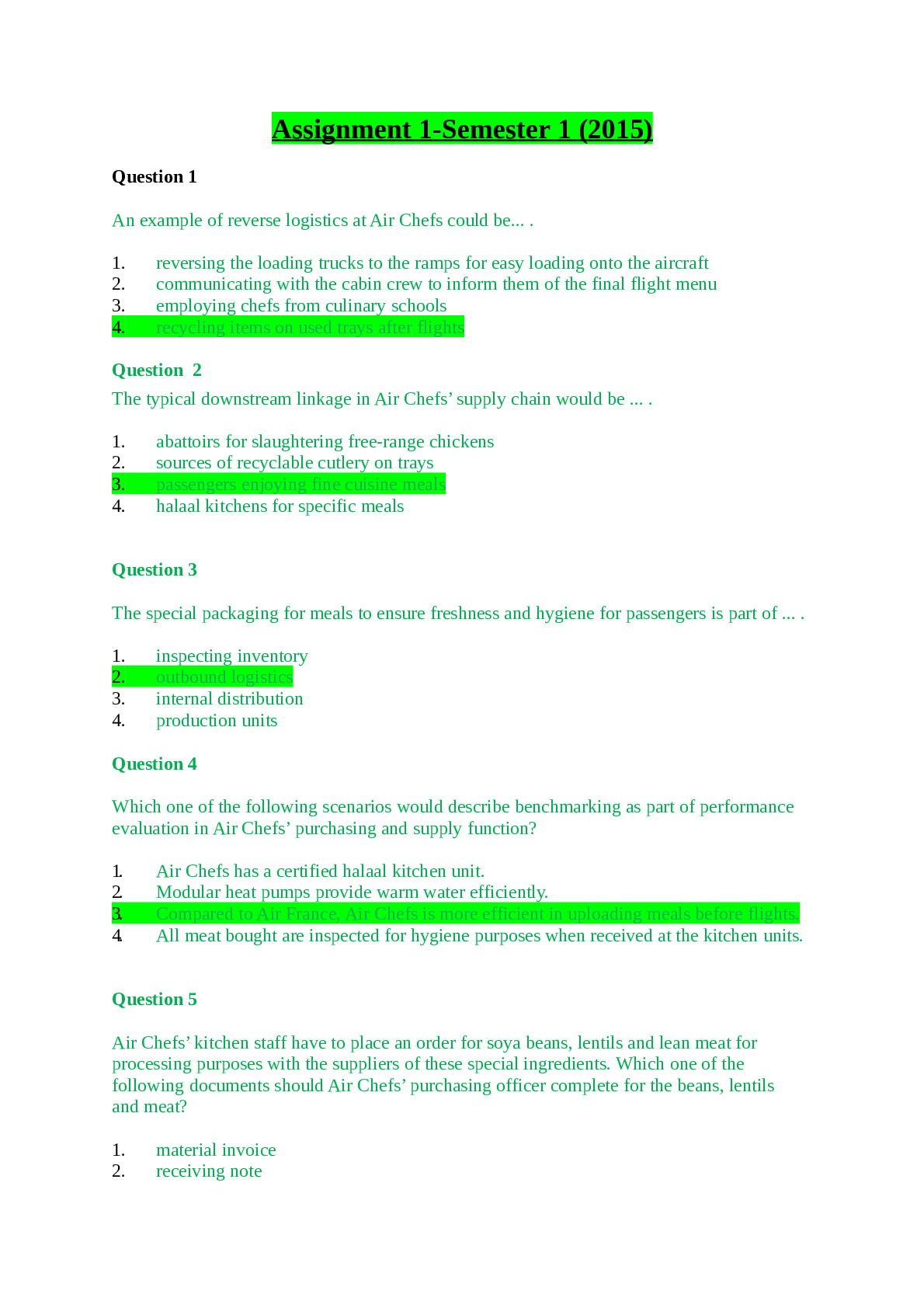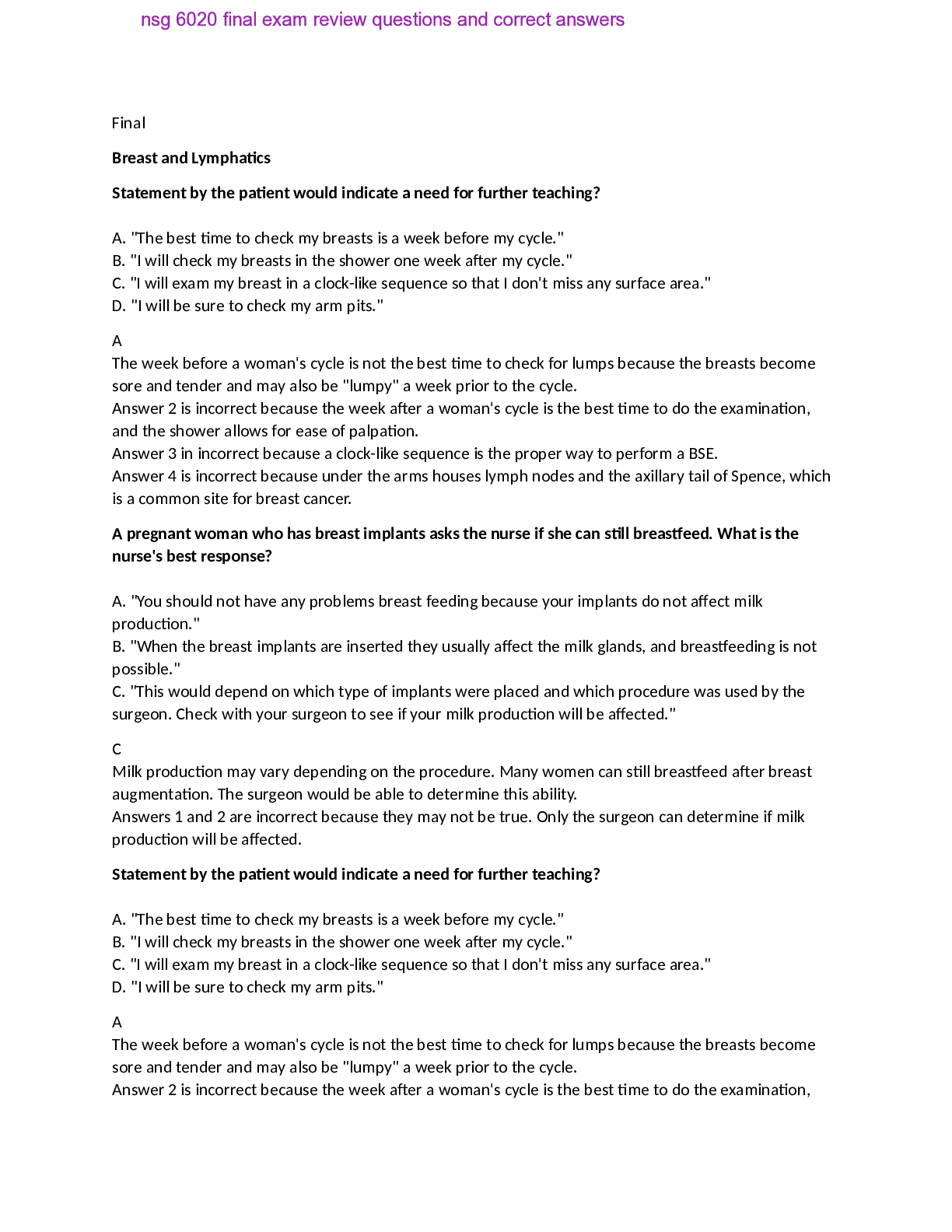Medical Studies > Final Exam Review > Final Study Guide Medical Surgery (All)
Final Study Guide Medical Surgery
Document Content and Description Below
Review headaches o vascular headaches: migraines, cluster, HPT migraines: prodromal (early s/s): aura, visual field defects, unusual smells or sounds, disorientation, paresthesia o tensio... n headaches o traction-inflammation headaches respiratory disease- interventions- respiratory alteration? O2 status o can only administer 2-4L of oxygen without prescription needed o listen to lung sounds, position pt to high fowlers delegation o what uaps can and can’t do- can help with ADLs, basic care and vitals of stable pts, no medications hypovolemic shock- interventions- restoring blood volume- replace loss hmt and hgb- manifestation- roles of RBCs o can be caused due to hypovolemia-dehydration- due to vomiting, diarrhea, hemorrhage, polyuria, inadequate fluid intake. Increase BP, threading pulse (weak pulse), tachycardia, cold calmly skin and fleshy skin, sunken eyes, tenting packed RBCs given to restore blood volume and replace HMT and HGB levels- give more fluids, give albumin to increase BP, oxygen to prevent hypoxia, sodium-bicarb due to increase acidosis, orthostatic hypotension, oliguria, diaphoresis, weight every 8 hrs, vitals every 15 min HPT- risk factors- values- assessment-intervention-teaching o Exercise 5x/ week 30 min o High level of potassium-obtain 12 ECG- indication of abnormal rhythm: dysrhythmia. Typical abnormalities in o Risk factors: smoking, race (African), obesity, stress, family history, sedentary lifestyle, alcohol, age >60 or postmenopausal, excessive alcohol o Interventions: reduce BP and prevent or lessen extent of organ damage, 12L EKG/ECG monitor for heart rhythm and report changes o Teaching: diet, stress reduction o Assessment: may be asymptomatic, headache, visual disturbance, dizziness, chest pain, tinnitus (noise or ringing in ears), flushed face, epistaxis (nosebleed) o Parameters Normal: <120/ <80 Pre-HPT: 120-129 systolic OR 80-89 diastolic HPT Stage 1: >140-159/ >90-99 HPT Stage 2: >160/ >100 Medications for HPT- beta blockers- ace inhibitors-s/e-assessmentintervention-teaching- Labs-meds- risk factors o “-il” = ace inhibitor, “-olol” = beta blockers o Lisinopril- ACE inhibitor Prevents vasoconstriction Can cause sexual dysfunction and impotence Swelling on tongue o Metoporlol and Ateneolol- Beta Blockers Beta blockers such as atenolol dilate peripheral arteries, sudden position changes can cause dizziness, lightheadedness, or syncope. These responses are most prominent when beginning the drug. To promote safety, especially for older adults, the nurse should teach the patient taking beta blocker to change position very slowly. Blocks sympathetic nervous system (beta adrenergic receptors) and produces a slower heart rate Monitor for bradycardia Can increase risk of bleeding Gathering subjective and objective data- assessment/physical o Objective: heart rate, blood pressure, respirations, wound appearance, ambulation description o Subjective: pain, any data gathered from pt telling you something Pre-op consent/ pt teaching incentive/ understanding procedure- intra-opthings to do, things happening, do for pts in post-op o Incentive spirometer: take deep breath, inhale with device, exhale out prevents atelectasis, improves lung expansion/oxygenation. Pt turn and cough deep breath, ever 2 hrs, turn pts side-back-side cough forcefully and splint if needed. Do not do in pts with ICP pressure surgeries or ent spin surgeries. o Pre-op: Things that should be reported: cardiac problems, airway concerns, recent airway infections, COPD or asthma, history or smoking, pregnancy, eating/drinking prior to surgery Prophylactic antibiotics within 1 hr of a surgical incision Informed consent: LEGAL PREP Provider: discuss procedure, describe risks and benefits, their ability to refuse, any alternatives RN: can only CLARIFY, witness consent after client acknowledges understanding, it is OUT OF SCOPE if pt doesn’t understand PT: pt with mental illness does not mean they cant consent. Once consent is signed, it can still be withdrawn Before anesthesia- ask pt to confirm name, DOB, surgical procedure, site and consent Wrong surgical procedure and surgery performed on wrong body part or wrong pt are defined as a sentinel events Manifestations hypovolemic shock- thromboembolism risk factors o VTE-what do you look out for- teaching/ manifestations dos and don’t o Development of blood clot in deep veins- starts at DVT then develops to embolism o Risk factors: venous stasis, hypercoagulability, trauma of a blood vessel, immobilization after surgery o Manifestations: pain, edema, erythema, warmth, tenderness along vein o Do not massage legs, anti-embolic stockings o Measure stockings: from heel to popliteal space Deep vein thrombosis- most important aspect/ open-reduction internal fixation o Elevate the extremity above heart level o At risk for pulmonary embolism o Compression stocking, frequent position changes, early ambulation o Do not massage pt legs-can travel o Dull aching calf pain o Compare legs size, temp, edema o Pt at risk: given blood thinners: warfarin & heparin together due to effectiveness- for therapeutic levels (anti-coagulant meds) o Warfarin & ginkgo: bad reaction-cannot take with it o Warfarin & glucosine cannot be taken together Differentiate between clear, full liquid diets o Clear: only liquids you can see through/ little residue-broth, clear fruit juices, gelatin o Full: thicker, clear liquids plus liquid dairy products, all juices. ABGs o Role- measures acidity (pH) and levels of oxygen and carbon dioxide in the blood from an artery- used to check how well lungs are able to move oxygen into the blood and remove carbon dioxide from the blood o Ph: 7.35-7.45 <7.35= acidosis >7.45= alkalosis o HCO3: 22-26 <22: metabolic acidosis >26: metabolic alkalosis o CO2: 35-45 <35: respiratory alkalosis >45: respiratory acidosis Skin assessment- stage 1, 2,3, 4- teaching o Stage 1: intact skin with non-blanchable redness. Possible indicatorsskin temp., tissue consistency, pain. May appear with: red, blue, or purple hues in darker skin tones Dressing changes: transparent & hydrocolloid o Stage 2: Partial-thickness loss of dermis. Shallow open ulcer with red pink wound bed. Presents as an intact or ruptured serum-filled blister Dressing changes: composite film, hydrocolloid, hydrogel o Stage 3: full-thickness loss can extend down to, but not through, underlying fascia. Presents as a deep crater with possible undermining of adjacent tissue. Depth of ulcer varies by anatomic location Dressing changes: hydrocolloid, hydrogel w/ foam, gauze, growth factors o Stage 4: full thickness loss can extend to muscle, bone, supporting structures. Bone, tendon, or muscle may be visible or palpable. Undermining and tunneling may occur Hydrogel, calcium alginate, gauze o Unstageable: cannot determine depth of damage due to exudates, necrosis, or eschar Adherent film, gauze, enzymes Albumin, protein, vitamin C, on skin ulcers o Promotes wound healing Assess respiratory status on elders o Assess for falls- what to identify o Assess room for any risks Manifestation GI bleeding (what to look for when someone is bleeding internally) o dark tarry stools and red blood in stool- if dark it is from upper GI GERD- teaching-manifestations-assessments o Backflow of gastric and duodenal contents into the esophagus o Causes: Incompetent LES/lower esophageal sphincter, Pyloric stenosis, Hiatal hernia, Excessive intra-abdominal or intragastric pressure, Motility problems o Assessments: heartburn, epigastric pain (upper abdomen), dyspepsia, nausea, regurgitation, pain/difficulty swallowing, hyper salivation o Teachings: avoid coffee, chocolate, fried or fatty foods, carbonated beverages or alcoholic beverages, cigarette smoking. Pt should eat low fat, high fiber diet, avoid eating and drinking 2hrs before bedtime and wearing tight clothes o Elevate head of bed, emesis basin, o Ice chips- do not eat within 2-3hrs before bed o Radiating pain-neck/jaw/back IBD diet question-food choices o Functional disorder characterized by chronic or recurrent diarrhead, constipation, and/or abdominal pain & bloating o Increase dietary fiber, drink 8-10 cups of liquids per day Diabetes- type 1 and type 2- risks- hypoglycemic/ hyperglycemic o Type 1: insulin dependent, autoimmune disorder, destruction of B cells occurring for months to years before symptoms occur, manifestations develop when pancreas can no longer produce sufficient insulin to maintain normal glucose. 3 Ps: polydipsia (excessive thirst), polyphagia (excessive hunger), polyuria (frequent urination) o Type 2: non-insulin dependent. Pancreas continues to produce endogenous insulin but not enough insulin is produced OR body does not use insulin effectively. relative lack on insulin or resistance to the action of insulin, insulin is sufficient to stabilize fat and protein metabolism but not carbohydrate metabolism Risk factors: abdominal obesity, hyperglycemia, HPT, high triglyceride level, a lowered HDL cholesterol level o Assessments: polyuria, polydipsia, polyphagia- all more common in type 1 DM. Hyperglycemia, weight loss (common in type 1, rare in type 2), blurred vision, slow wound healing, vaginal infections, weakness and paresthesia (tingling, pricking, chilling numbness), signs of inadequate circulation to feet o Hypoglycemia occurs when the blood glucose level falls below 70mg/dL or when the blood glucose levels drop rapidly from an elevated level, can be caused by too much insulin or too large an amount of an oral hypoglycemic agent, too little food, or excessive activity-pt should carry emergency foods (fast-acting simple carbohydrates) o Dietary adjustments for pts with nephropathy and DM- consume less than 08. g/kg of body weight of protein per day, 45%-65% carbs per day, less than 200 mg of cholestrol per day, 25 g per day of fiber for women and 38 g per day for men o Hypoglycemia-sweating, tremor, tachycardia, palpitations, headache, fatigue, nervousness, hunger o Hyperglycemia- dehydration, fruity breath odor, nausea, vomiting, warm, moist skin Teaching medication- Biguanides- metformin(Glucophage)- when is it given o Most common for type 2- take with food-never crush or chew o Reduces glucose production by liver-enhancing insulin sensitivitymay cause weight loss- take with food never crush or chew o May need to be discontinue 48 hrs before surgery (can increase risk on renal failure) and may not be restarted until renal function is normal postop o Monitor for serum creatinine Glipizide- s/e what is it for- pt teaching o Stimulates insulin release from pancreas causing decrease in blood sugar levels. Major s/e: hypoglycemia o Administer 30 mins before meals, avoid alcohol Manifestations of diabetes insipidus- peeing like no tomorrow o Excretion of large amount of dilute urine, polydipsia, dehydration (decreased skin turgor and dry mucous membranes), inability to concentrate urine o Fatigue, muscle pain, weakness Diabetic teaching-diet/ time for insulin and time of breakfas [Show More]
Last updated: 1 year ago
Preview 1 out of 15 pages
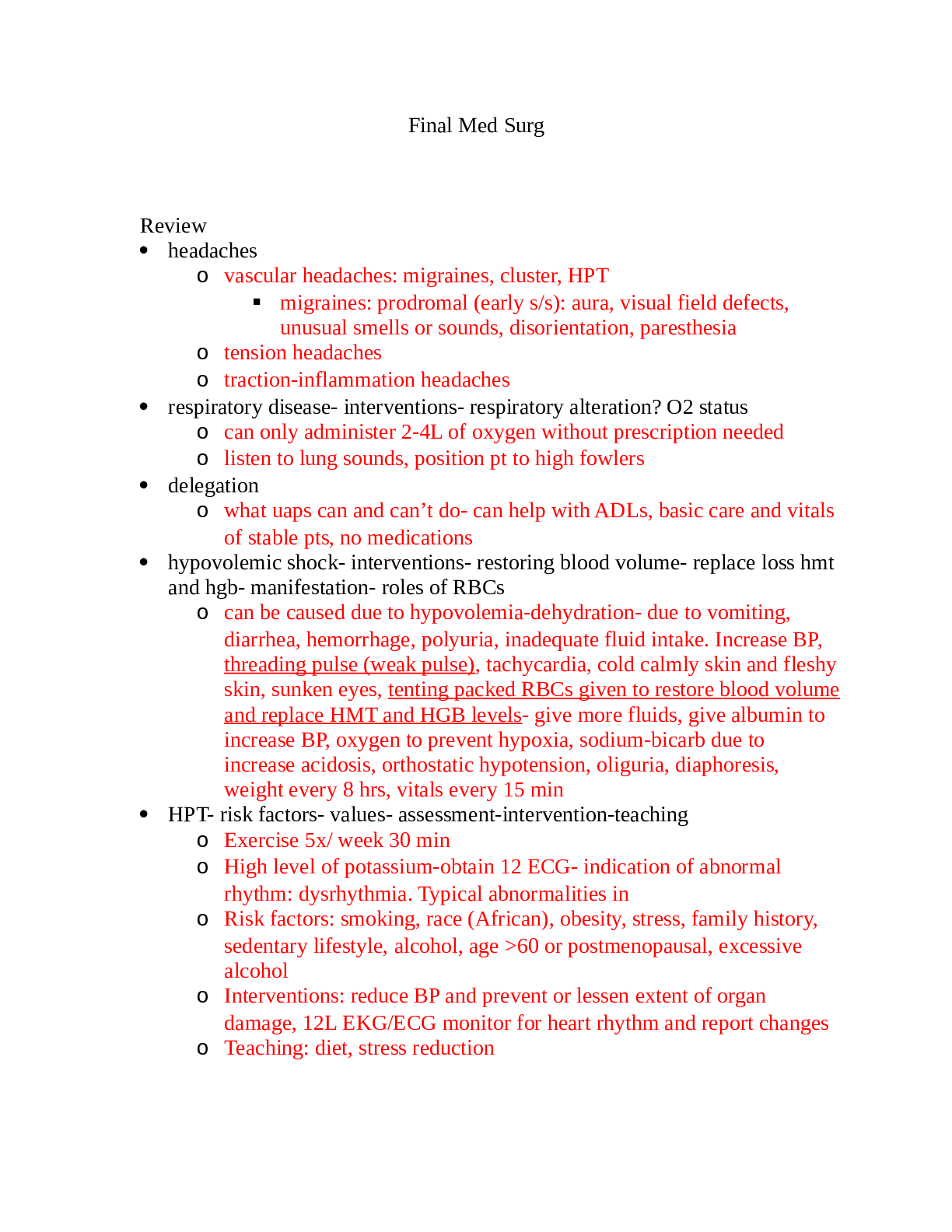
Reviews( 0 )
Document information
Connected school, study & course
About the document
Uploaded On
Jul 03, 2021
Number of pages
15
Written in
Additional information
This document has been written for:
Uploaded
Jul 03, 2021
Downloads
0
Views
88

